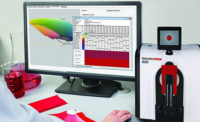Color Management 101: The Latest Technology and Techniques
Whether you are first introducing color control to your quality process or you are managing an existing framework, here’s what to know.

Uniformity has long been associated with quality perception, and color can be one of the most striking visual giveaways if products are inconsistent. As a result, consumers are more likely to associate these color flaws with inferior, low-quality products or brands.
Because of this, it is important for industries to establish an acceptable level of color variation tolerance, and then put processes and procedures in place to ensure colors stay within these ranges. Otherwise, inaccurate color can potentially cost businesses hundreds of thousands of dollars and delay product to market.
However, color can be surprisingly difficult to replicate and manage. This is partially because we all see and interpret color differently, making visual color evaluations unreliable. In fact, variations in your environment—like light, altitude and noise—can affect color perception. That is why objective color management is only feasible with the right color control tools in place as part of an overarching quality control process.
Whether you are first introducing color control to your quality process or you are managing an existing framework, here are the latest technologies and techniques you should be aware of.
The Latest Technology
Having the right technologies and tools in place is essential for an effective and modern quality control process. Typically, a comprehensive color management program is inclusive of hardware and software technologies that, when used together, will help you accurately measure, display, analyze and communicate color.
There are two primary types of instruments to consider: colorimeters and spectrophotometers.
Colorimeters
A tristimulus color measurement tool that provides an objective evaluation of color characteristics based upon one light and one observer condition, simulating how the human eye perceives color
Colorimeters are a simple, relatively inexpensive instrument that are often used for quality control purposes but cannot be used to calculate color formulas. They are best used for straightforward color identification, comparison of similar colors and shades, measurement of color strength or fastness, color quality control, assessment of non-metameric color batches and as a source of reference for determining color standards.
Spectrophotometers
Spectrophotometers measure light reflected or transmitted across the visible spectrum and compare it to reference samples. These instruments provide spectral data that can be used to calculate tristimulus values for various conditions and calculate color recipes for commercial color matching, generating color data that is beyond observation by the human eye.
Color is a surprisingly difficult thing to get right.
This is a higher-end solution for more complex color needs offering greater functionality and higher precision. They are best used for color measurement and formulation, monitoring of color accuracy throughout production, maintenance of color consistency throughout the supply chain, identification of metamerism, measurement of opacity and haze, color quality color, and detection of impurities. There are also multiple geometries of spectrophotometers, depending upon your industry’s specific needs.
So, which of these technologies will meet your needs? Start by asking yourself these questions:
- What is your desired application, price range and instrument complexity needs?
- Can you bring samples to your instruments or must you bring your instruments to your samples? This will impact whether you need a benchtop vs. portable instrument.
- Do you need to measure samples that are textured, multi-colored or composed of multiple very small parts? You may need to consider a more advanced hyperspectral spectrophotometer capable of these complex measurements.
It is important to prioritize quality products that are intuitive to use and tailored to your industry’s specific requirements. Quality standards can vary significantly from industry to industry, so considering these elements is essential to ensuring you make appropriate technology investments. For those with manufacturing plants spanning multiple geographies, it is imperative to look for technologies with the highest level of inter-instrument agreement to ensure compatibility between your instruments and across your supply chain.
Failing to implement these best practices can introduce a significant potential for error into your color management process.
When comparing color control instruments, it is important to keep in mind that you should not compare the degree of color variation (DE) from one system to another. This is because spectrophotometer and colorimeter manufacturers often use different systems for defining color differences within color spaces (e.g., CIELab, CIE94, CMC, CIE2000, etc.). These systems each have their own purpose and merit, but there is no way to convert one system to the other in order to directly compare technologies using different systems. And because the industry has not standardized color spaces, there is no formal guidance regarding which system is preferred.
You also want to ensure that your technology vendor offers an exceptional level of service and support to guide you throughout this process and help you adapt as your needs change. Your partner should offer a full suite of technology solutions to help you scale up as your business grows. Finally, make sure you can keep up with the ever-changing quality management and manufacturing landscapes by partnering with future-focused technology providers preparing to offer cloud-based software and other solutions to keep you on the forefront of innovation.
Measurement Techniques
Once you have the proper tools in place, you need to properly maintain and operate your technology in order to get accurate, repeatable results. Failing to implement these best practices can introduce a significant potential for error into your color management process.
Maintenance, testing and recalibration
Establish a regular maintenance and testing schedule. Adhere to manufacturer guidance when establishing these and schedule regular professional servicing. Frequent recalibration should be embedded into this schedule. In fact, some industries should consider recalibrating instruments every two to four hours and immediately before a particularly important job. Properly maintaining calibration standards will also help to ensure accurate measurements.
Environmental conditions
Ensure that the environment in which your instruments are operated is optimized for performance. Maintain a consistent ambient temperature and place hardware in areas that avoid direct sunlight. Aim for a stable, non-condensing humidity, and eliminate air contaminants, like chemical vapors and smoke.
Sample preparation and measurement
There are rigorous measurement guidelines to account for opacity, sample thickness, directional orientation and irregular color that should be adhered to whenever measuring samples. These change from industry to industry, so consult with your color management partner to ensure you are using a proper, repeatable measurement technique. An optimum measurement technique has been established when a sample can be measured, removed from the instrument, and then re-measured with a variation that falls below industry-established standards.
Color is a surprisingly difficult thing to get right. However, with the right color management tools and procedures in place, you can establish a comprehensive, accurate and repeatable quality control process. And if you have partnered with the right color management technology vendor, they can support you with the necessary training, customer support and maintenance needed for your success. Q
Looking for a reprint of this article?
From high-res PDFs to custom plaques, order your copy today!





